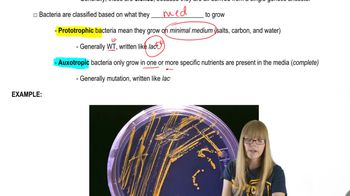5. Genetics of Bacteria and Viruses
Working with Microorganisms
Practice this topic
- Multiple Choice
What is a plasmid?
- Multiple Choice
True or False:All bacterial cells within a bacteria colony grown on a plate in a laboratory are genetically identical.
- Multiple Choice
Which of the following is NOT a way scientists can phenotypically identify a bacterial mutation?
- Open QuestionIn this chapter, we have focused on genetic systems present in bacteria and on the viruses that use bacteria as hosts (bacteriophages). In particular, we discussed mechanisms by which bacteria and their phages undergo genetic recombination, which allows geneticists to map bacterial and bacteriophage chromosomes. In the process, we found many opportunities to consider how this information was acquired. From the explanations given in the chapter, what answers would you propose to the following questions?How do we know that bacteria undergo genetic recombination, allowing the transfer of genes from one organism to another?
- Open QuestionIn this chapter, we have focused on genetic systems present in bacteria and on the viruses that use bacteria as hosts (bacteriophages). In particular, we discussed mechanisms by which bacteria and their phages undergo genetic recombination, which allows geneticists to map bacterial and bacteriophage chromosomes. In the process, we found many opportunities to consider how this information was acquired. From the explanations given in the chapter, what answers would you propose to the following questions?How do we know that genes exist in bacteria and bacteriophages?
- Open Question
Fifteen bacterial colonies growing on a complete medium are transferred to a minimal medium. Twelve of the colonies grow on minimal medium.
The serine biosynthetic pathway is a three-step pathway in which each step is catalyzed by the enzyme product of a different gene, identified as enzymes A, B, and C in the diagram below.
Mutant 1 grows only on In addition to growth on , mutant 2 also grows on and . Mutant 3 grows on and . Identify the step of the serine biosynthesis pathway at which each mutant is defective. - Open Question
Fifteen bacterial colonies growing on a complete medium are transferred to a minimal medium. Twelve of the colonies grow on minimal medium.
The three colonies that do not grow on minimal medium are transferred to minimal medium supplemented with the amino acid serine and all three colonies grow. Characterize these three colonies.

